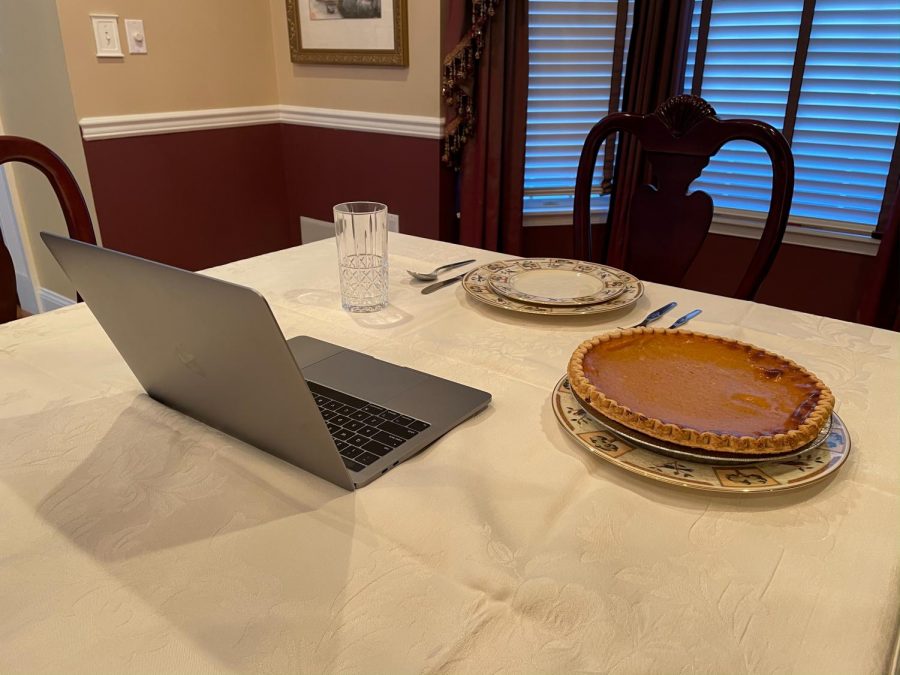Traveling for Turkey: Staying Safe During the Holiday
Celebrating Thanksgiving virtually is the safest option this year.
November 25, 2020
Like most other major events this year, this Thanksgiving will be one like no other, as formerly harmless gatherings can now become potential sources of a coronavirus outbreak.
Here’s a breakdown of the different ways to celebrate this year in a safe and responsible way.
Alternative Options
The safest way to spend this holiday is to celebrate at home with the people you live with. According to the Centers for Disease Control and Prevention (CDC), visiting friends and family who don’t live with you can increase your chances of contracting or spreading COVID-19 or the flu.
Instead of inviting other friends and family to your house, invite them to a virtual gathering using platforms like FaceTime, Skype or Zoom. Zoom will lift its free 40-minute meeting time limit for Thanksgiving Day. While not ideal, such virtual services provide the safest option because they limit in-person contact.
All normal coronavirus protocols apply while in transit: wear a mask, stay 6 feet apart, wash your hands or use hand sanitizer, and avoid touching your face.
What to Consider Before Traveling
For those who can’t stay away from large family gatherings, there are a few things you should consider before making plans. Ask yourself whether you, anyone you live with or anyone you will visit is at increased risk of getting sick from COVID-19. These people typically include older adults and people with medical conditions. People in statistically more vulnerable racial and ethnic minority groups should take extra precautions as well.
The CDC also advises that pregnant women and breastfeeding mothers, people with disabilities, people with substance use disorders, people living in rural communities, people experiencing homelessness, newly resettled refugees, and people living in group homes should also be especially careful.
In addition to thinking about who you might see, check your destination for the latest information about COVID-19 cases. Traveling to places with rising cases could lead to increased exposure. Johns Hopkins University of Medicine has up-to-date information on areas as specific as individual counties. Check state and local requirements to see if the location to which you are traveling has any requirements for new arrivals.
Also, check travel restrictions in the area where you will be traveling. If you haven’t already gotten your flu shot, be sure to get it before traveling. All normal coronavirus protocols apply while in transit: wear a mask, stay 6 feet apart, wash your hands or use hand sanitizer, and avoid touching your face. The CDC is also urging anyone sick with COVID-19 symptoms to delay their travel plans. This also applies to those who have recently tested positive or have come in contact with a person who has tested positive or are awaiting COVID-19 test results.
Thanksgiving Day
If you plan on attending an in-person Thanksgiving gathering, there are ways to make the celebration safer. The CDC recommends bringing your own food, drinks, plates, cups and utensils. Additionally, while you should wear your mask when not actively eating or drinking, you should store your mask safely. If it is wet or dirty, make sure to keep it in a sealed plastic bag, and if it isn’t, then you should store it in a dry, breathable bag to keep it clean between uses. The CDC also advises that you avoid going in and out of areas where food is being handled and to also use disposable food containers, utensils and condiment packets.
If you plan on hosting a Thanksgiving gathering, you also have the responsibility of creating the safest environment possible for everyone involved. While that means following all the guidelines above for attending a gathering, there’s more you can do to stay safe.
First, consider hosting your event outdoors. Research from the Mayo Clinic suggests that indoor gatherings pose greater risks because you are more likely to inhale droplets from infected people. In contrast, being outdoors, where fresh air is constantly moving and dispersing these droplets, decreases the likelihood of breathing in infected droplets.
The second thing to consider is your guest list, which should be as small as possible.
If you must hold your event indoors, opening windows to allow airflow from the outside can make the environment safer.
The second thing to consider is your guest list, which should be as small as possible. Although the CDC suggests people stay at least 6 feet apart, some state governments have set their own limits. For New York, Gov. Andrew Cuomo set the limit at 10 people. Be sure to check your local requirements. AARP compiled a list that outlines policy state by state. During the event, clean and disinfect high traffic areas and items. To do this, the CDC recommends wearing gloves and cleaning surfaces with soap and water first, then using disinfectant.
As the host, you also have the responsibility to regulate who goes in and out of the kitchen. To save time and decrease the risk associated with washing dishes, have guests bring their own food and drink. If sharing food, the CDC also encourages having one person serve food using single-use options like plastic utensils. If you do insist on hosting an event this week, one thing to increase your safety is to make sure everyone invited is on board to follow your predetermined coronavirus protocols.
Remember, the safest way to celebrate Thanksgiving is in person with those with whom you live and virtually with anyone else. Although there is no guarantee for a completely safe Thanksgiving, following these guidelines can help.





















